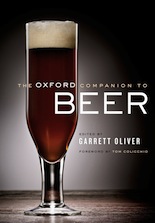
Oxford University Press
Hardcover, $65, 960 pages
Rarely has a publication produced such an out-pouring of excitement, praise, analysis, criticisms—and, even—condemnation. To say this giant of a book is controversial could be the understatement of the year.
That the Oxford Companion to Beer is a long overdue compendium of beer information is a fact. Nearly 1100 pages with as many as 800 words per page, make it the most ambitious beer book published to date. It goes both deep and long on every aspect of beer, which makes it a must-have for all beer lovers but also a seriously huge target for every beer geek.
I fall into the former category, given I’m an unabashed fan of all things Garrett—beers, presentations, writing, even his wide assortment of hats are a pleasure to behold. It is no surprise, therefore, that a copy of the OCB sits on each of my desks—both work and home—open to whatever caught my eye when I sat there last.
And this is the joy of Garrett’s work: Open anywhere and enjoy the read. Take his entry for Michael Jackson. A whole generation of beer lovers is coming to the forefront without the direct experience of Michael Jackson. Garrett’s entry does justice to Jackson’s impact on our lives. Or the entry on porter—a favorite beer style of mine—which takes on both myth and archives, in order to present a “most likely” narrative of the style. At the office, we just popped open a bottle of Cascade Brewing’s Kriek Ale, and here I am flipping through his book to see what he says about Krieks.
However, the comprehensive quality of the tome has exposed it to the “slings and arrows” of beer geekdom. While a few of the more outraged souls could be condemned to the jail for “ranters,” a majority have some very specific objections, which, if anything, are a testament to the extent of beer scholarship these days.
Let’s face it. Today’s beer world is populated with eager beer-loving souls who are doing yeoman’s work in the archives, unraveling the history, culture, technology, aesthetics of our beer world. For example, one critic posted images of brewery records from a century or so ago to backup his disagreement with the thrust of a specific entry. Unlike other consumer goods, say wine, beer lovers are eager participants in growing the experience of beer.
And herein lies the strength of the OCB. It is unquestionably the largest, and most complete, source of beer information/education for the average beer lover. For this reason, it has brought out of the woodwork even better beer research. Garrett has already written that this will only contribute to the value of future editions. It is an old fashion version of today’s social media mantra—customer interaction.
This book will become the epicenter of beer scholarship as beer lovers contribute their own observations, recommendations and insights. The next one can only be better.









